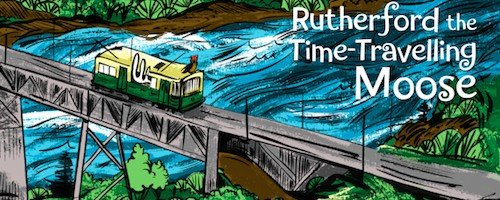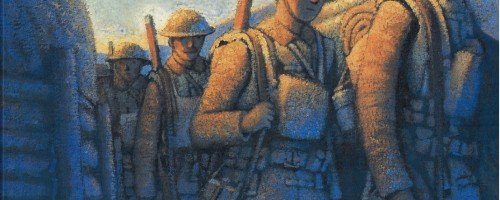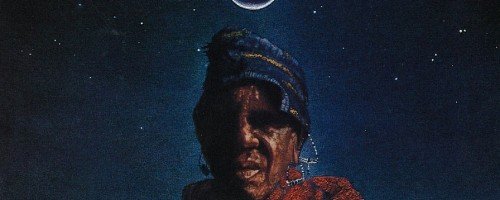“I rhyme/To see myself, to set the darkness echoing.”
– Seamus Heaney, Personal Helicon
Heaney’s statement, about the act of writing, also resonates for me as a reader. We read to see ourselves – to illuminate our present and our past – to set the darkness echoing.
In Edmonton we rarely, if ever, are given the opportunity to see ourselves and our city reflected in the pages of a book. There have been strides in adult literature, but until the publication of Rutherford the Time-Travelling Moose, there have been no picture books celebrating Edmonton for children.
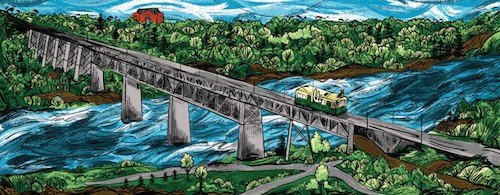
Rutherford the Time-Travelling Moose was initially conceived as a picture book about Edmonton’s history in the context of Rutherford House, the home of the first Premier of Alberta, Alexander Rutherford (1905-1910). The Friends of Rutherford House Society issued a call for story proposals and Thomas Wharton, an award-winning local author, won the bid along with illustrator Amanda Schutz, also a resident of Edmonton.
Wharton was commissioned to “animate” the bones of the story, taking it beyond its original confines to the places in Edmonton the premier and his family would have known.
The journey begins with a young girl named Robin who is visiting her grandmother at an old brick house on Saskatchewan Drive. (Readers in Edmonton will recognize this as Rutherford House.) The smell of cookies baking in a cast-iron stove elicits a conversation about Edmonton’s past. In wanders Rutherford the moose, hungry for his regular Wednesday ‘cookies and tea’ and eager to help Robin with her questions. (For international readers of this blog, please note that in Edmonton moose typically do not wander into people’s homes. Backyards, yes, but…)

As luck would have it, Rutherford is a time-travelling moose. Astride his back, Rutherford spirits the adventurous girl back to the ice-age and then travels forward through various eras, including a visit to a First Nations settlement along the banks of the North Saskatchewan River, fur traders at Fort Edmonton, an early 20th century legislature (where the Famous Five can be spotted in the foreground), the High Level Bridge with a streetcar running along the top (as its facsimile does to this day) and other recognizable Edmonton landmarks and historical touch points.
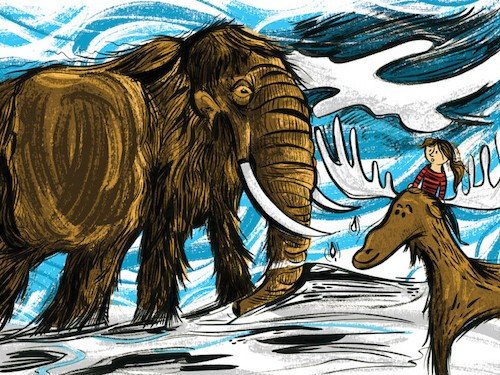
Unless you’re from a major city like New York or London, like me you probably get excited when you see familiar people and place names in books, simply because it doesn’t happen that often. This alone makes Rutherford the Time-Travelling Moose essential reading for every child in Edmonton, but it’s particularly gratifying as an illustration junkie to see my city presented so beautifully. Schutz’s bold and colourful palette serve Edmonton well, and her humourous characterizations keep the mood light and fun.
The project took six months from beginning to end, which according to Wharton – author of seven novels – is the fastest he’s ever worked. “Writing the YA trilogy Perilous Realm took every ounce of my skill and effort because I had to try and get myself into the head of a younger reader,” he says. “That was a good learning experience and in some ways it prepared me for Rutherford the Time-Travelling Moose. It made me realize I had to think about who I was writing for, and how they see the world.”
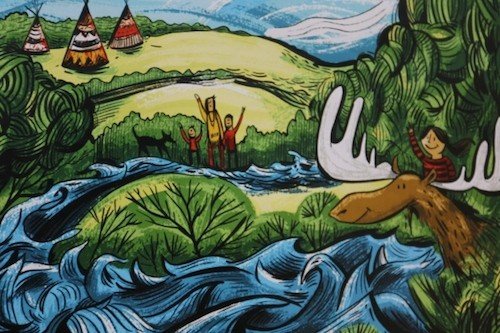
Schutz was equally sensitive to needs of her audience and to the historical accuracy in her depictions (Rutherford House provided photographs from the provincial archives), but working and living in Old Strathcona proved a definite advantage. “It was very easy for me to pop over to Whyte Ave or Strathcona Library to take images, or think about what elements were important to include in in the book,” says Schutz. “I added a few personal touches. For example, in the Garneau scene a red pick up truck is featured in the foreground. This truck was my grandpa’s old Ford Ranger, which he sold to me for a dollar when I turned 16 and got my drivers license.”
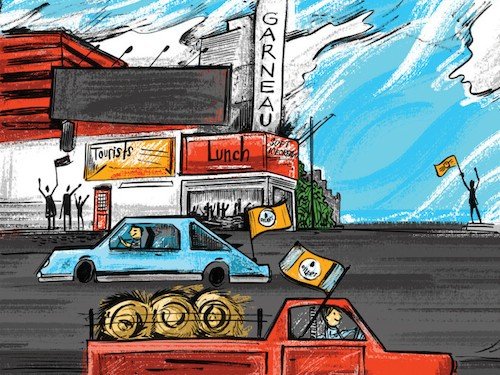
Wharton admits that working within the constraints of a 32 page picture book was a challenge. “What took most of the work was figuring out how much text we could put on each page, how many visits to different time periods and figuring out how it would look on the page,” he says. “A lot of that was done when Amanda came on board. When I first saw her work, I already had the idea in my mind that this would be a fun, a fast-paced story, and Amanda’s style fit that perfectly. The story came together that way.”
It was Wharton’s idea to use a moose as the ‘vehicle’ for time-travel, based on his own experiences observing the “big, ungainly” animals on the acreage he shares with his wife. It was also his decision to make Robin a girl. “At first we talked about avoiding gender, just making this a kid, which is why I chose the name Robin,” he explains. “It’s a kid, so take your pick, but that proved to be really problematic and clunky in terms of the pronouns. Eventually I decided to make her a tomboy. So she’s got a ponytail, but she’s in pants and she’s a real go-getter.”
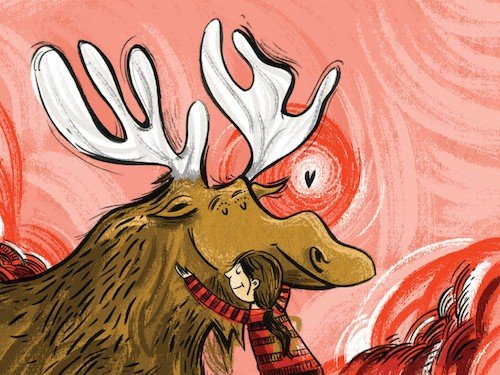
For children, seeing yourself reflected in the pages of a picture book is important in terms of cultural and experiential awareness. It’s identity-building. Even for adults, a picture book like this provides a colourful doorway into our city’s history – a history that for most of us is a blank page. “We tend to get inundated like everyone else with American culture, and we forget that we have our own,” says Wharton. “But I think it’s important that people understand how things got to be the way they are.”
Indeed. Rutherford the Time-Travelling Moose leaves the reader, young and old, hungry for more Edmonton(or moose)-based stories.
It’s time to set that darkness echoing.
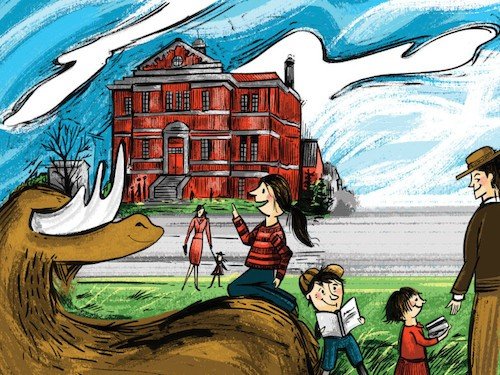
THOMAS WHARTON is the award-winning author of the young adult trilogy Perilous Realm and the Alberta-centric novel Icefields (a Canada Reads finalist). Wharton was born in Grande Prairie, Alberta and is currently an associate professor of writing and English at the University of Alberta in Edmonton.
AMANDA SCHUTZ is an Edmonton-based illustrator and designer. Schutz is the creative director of the design firm Curio Studio and her work has appeared in many children’s books and publications.
RUTHERFORD THE TIME-TRAVELLING MOOSE by Thomas Wharton, with illustrations by Amanda Schutz. Rutherford House, 2015
ABOUT RUTHERFORD HOUSE
The story of this book originally appeared in the University of Alberta/Faculty of Arts WORK OF ARTS blog. You may recognize a few phrases…
